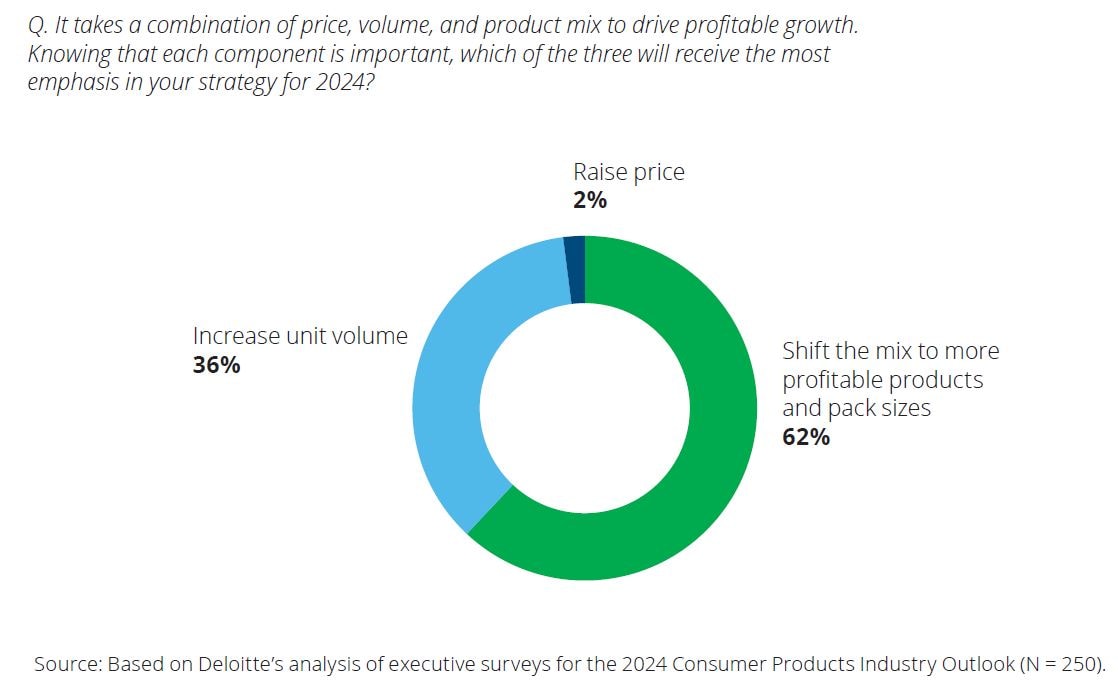2024 consumer products industry outlook has been saved

Perspectives
2024 consumer products industry outlook
A pivot to 'profitable volume'
While winning approaches to 2024 may revolve around fundamentals like price, volume, and mix, consumer products leaders will also likely confront newer challenges like generative AI, weight-loss drugs, or emerging regulations. Learn more in our 2024 consumer products industry outlook.
A new playbook for consumer products companies
For the last few years, growth for consumer products companies—spanning food and beverage, household goods, personal care, and apparel—relied on price taking. Input costs rose dramatically, so price had to follow—to near-unprecedented levels.
That strategy seems to have worked for several companies: Looking at the highest performers among the global top 100 companies in the consumer products industry by revenue, we see they were able to raise prices as much as, if not more than, others, with smaller hits to volume and more margin growth. The larger group of these “Profitable Growers,” reveals important lessons about pricing power, revenue growth management (RGM), innovation, supply chain smarts, and a willingness to prune and refresh their business portfolio and product set perpetually.
Those lessons will likely be as important in 2024, but the world is changing. Further significant price increases might not be possible in an uncertain economy where retailers are pushing back, and consumers are unwilling to pay more and often trade down. In our 2023 Outlook, eight in 10 executives surveyed planned to increase prices. Now, only 2% said their company’s profitable growth approach would emphasize raising prices.

So, to what new growth formula might the industry turn? If price has run its course, companies may need to pivot to volume. But not all volume is equal. Companies that aspire to Profitable Grower status in 2024 should consider profitable volume. That means executing a plan that carefully grows volume with an innovative and more profitable product mix while retaining as much pricing as practical.
For our 2024 Consumer Products Industry Outlook, we’ve created a profitable volume playbook, derived from financial performance and earnings transcript analysis, subject-matter specialist interviews, and a global survey of 250 consumer products executives. Its components include moves to boost both volume and profitability:
Volume
- Targeted advertising and promotion
- Precision growth management
- Opportunistic M&A
Profitability
- A rebalanced mix
- Strategic innovation
- Enhanced operations and supply chain
Of course, these factors are intertwined: mix affects price, price affects volume, and so on. The key is finding the right balance among them to drive profitable volume. Each leadership team in the C-suite should own part of the agenda to hit the mark (see role-based questions provided in “agenda for actions”).
Our 2024 consumer products industry outlook also includes a series of deep dives that span:
- A macro-economic outlook
- A view from the industry’s subsectors
- Executive perspectives on Gen AI and GLP-1
- A review of emerging regulations
- The mega trends affecting the industry’s long-term future
Download our full report to learn more about profitable volume and these trends and hot topics.
Economic outlook for the consumer products industry
The year 2024 will likely be characterized by slower economic growth than in 2023 and slower consumer spending growth. Yet it will probably be the last year of monetary policy tightening by major central banks. It is reasonable to expect a rebound starting in 2025. For global consumer products companies, it may make sense to focus on the longer term.
Dr. Ira Kalish, Chief Global Economist, Deloitte
Read the complete 2024 consumer products industry outlook by downloading the report.
About the report
Deloitte analyzed a worldwide set of the largest 100 public consumer products companies by revenue, drawn from S&P Capital IQ and filtered for industry definitional fit, e.g., excluding high-end luxury, tobacco, conglomerates with less than 50% of revenue from consumer products, etc. The team then used a five-year composite percentile index of both top-line growth and efficient use of assets (measured in return on assets) to assess relative success.
Deloitte also conducted a global survey of 250 consumer products executives spanning food & beverage, household goods, personal care, and apparel. All respondents were senior decision makers at companies with over $500M in revenue (most over $5B). They were sourced proportionally to roughly match the geographic markets and subsectors in the top 100 global consumer products company financial analysis.
Survey questions were developed through an analysis of trending topics found in company reports, earnings call transcripts, and analyst reports, as well as through exploratory surveys and interviews with financial analysts, investors, and Deloitte leaders. The team also deployed many of these same methods to determine what high-performing companies (on revenue and ROA indexes) were doing differently from the low-performing companies in our financial analysis.
Authors: Nick Handrinos, Leon Pieters, Dr. Jacob Bruun-Jensen, Justin Cook, Céline Fenech, Jagadish Upadhyaya

IndustryAdvantage™
Deloitte IndustryAdvantage offers deep industry insights with cutting-edge digital capabilities to position your business for the future. Explore how we can help you face your commercial, product, and operations challenges and gain a competitive advantage.
Get in touch
If you’d like to discuss any of the future consumer trends mentioned in the outlook or how your organization can drive CPG growth this year, let’s set up a conversation.
Recommendations
The future of the consumer industry: Buying into better
Learn more about the trends shaping the future of the consumer industry and how companies can help create a better tomorrow.
That Makes Cents: Future of Consumer Series
The consumer industry is about to undergo a once-in-a-lifetime shift. Learn how to lead with insights from industry luminaries and host Bobby Stephens.





